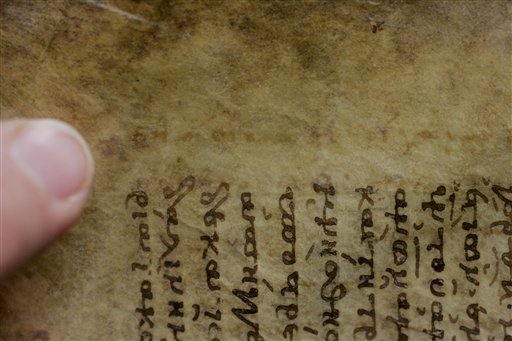
Particle accelerator helps decipher fragile 10th century manuscript

"Give me a place to stand, and a lever long enough, and I will move the Earth.”
-Archimedes, the Greek mathematician, upon discovering the principle of leverage
What knowledge of mathematics allows you to do:
Develop the mental skills to create and present a logical argument;
Gain experience in abstracting the essence of problems from a cluttered background;
Mix the systematic with the creative in the solution of problems;
Study the beauty of nature from the formal perspective of patterns and change.
Why Archimedes? Why not? Archimedes and the Roman Army.
Uwe Bermann, Stanford University's physicist, points to words from a manuscript by Greek mathematician Archimedes:
Previously hidden writings of the ancient Greek mathematician Archimedes are being uncovered with powerful X-ray beams nearly 800 years after a Christian monk scrubbed off the text and wrote over it with prayers.
Over the past week, researchers at Stanford University's Linear Accelerator Center in Menlo Park have been using X-rays to decipher a fragile 10th century manuscript that contains the only copies of some of Archimedes' most important works.
The X-rays, generated by a particle accelerator, cause tiny amounts of iron left by the original ink to glow without harming the delicate goatskin parchment.
"We are gaining new insights into one of the founding fathers of western science," said William Noel, curator of manuscripts at Baltimore's Walters Art Museum, which organized the effort. "It is the most difficult imaging challenge on any medieval document because the book is in such terrible condition."
Following a successful trial run last year, Stanford researchers invited X-ray scientists, rare document collectors and classics scholars to take part in the 11-day project.
It takes about 12 hours to scan one page using an X-ray beam about the size of a human hair, and researchers expect to decipher up to 15 pages that resisted modern imaging techniques. After each new page is decoded, it is posted online for the public to see.
On Friday, members of the public watched the decoding process via a live Web cast arranged by the San Francisco Exploratorium.
"We are focusing on the most difficult pages where the scholars haven't been able to read the texts," said Uwe Bergmann, the Stanford physicist heading the project.
Born in the 3rd century B.C., Archimedes is considered one of ancient Greece's greatest mathematicians, perhaps best known for discovering the principle of buoyancy while taking a bath.
The 174-page manuscript, known as the Archimedes Palimpsest, contains the only copies of treatises on flotation, gravity and mathematics. Scholars believe a scribe copied them onto the goatskin parchment from the original Greek scrolls.
Three centuries later, a monk scrubbed off the Archimedes text and used the parchment to write prayers at a time when the Greek mathematician's work was less appreciated. In the early 20th century, forgers tried to boost the manuscript's value by painting religious imagery on some of the pages.
In 1998, an anonymous private collector paid $2 million for the manuscript at an auction, then loaned it to the Walter Arts Museum for safekeeping and study.
Over the past eight years, researchers have used ultraviolet and infrared filters, as well as digital cameras and processing techniques, to reveal most of the buried text, but some pages were still unreadable.
"We will never recover all of it," Noel said. "We are just getting as much as we can, and we are going to the ends of the earth to get it."
View the archived live webcast.

The Approximation of Pi
Filed under: Archimedes, Exploratorium, Baltimore, museums

No comments:
Post a Comment